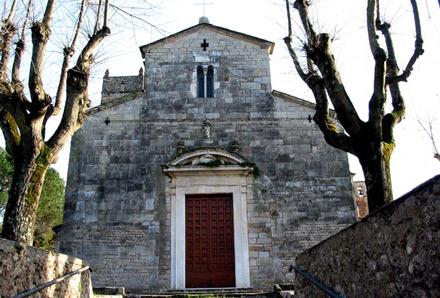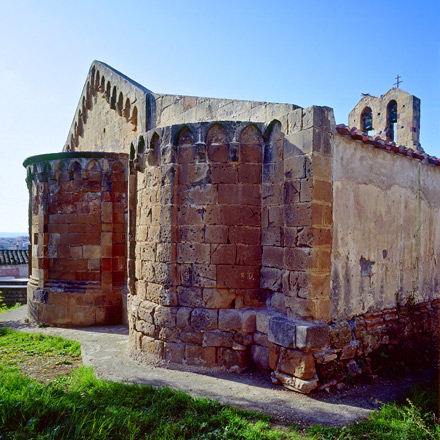The Church
At a few kilometres from Camaiore, lying on the hills bordering the Via Francigena towards the sea, the locality of Pieve appears with its few houses, dominated by the church of Santi Giovanni Battista e Stefano. An ancient pieve with jurisdiction on a wide territory, already existing in the 9th C., yet built in its present forms in the 12th century, it saw the growth and development of the centre of Camaiore until when, in the 14th century, it had to cede to the ‘town’ church the right to baptize, keeping but the place-name.
A steep uphill paved in ancient stones leads to the edifice. The monastic complex can be reached walking on the right side. Rich in history and stratifications, it is currently making the object of restoration works.
The baptismal font guarded inside is a late-ancient, reworked sarcophagus.
Description »
The church has got a three-nave, Latin-cross plan with semicircular apse. The façade hosts a large 17th-century portal replacing an unusual two-light opening, whose structure is still visible; up above is a small mullioned window with a simple, bell-shaped capital. The right transept, resulting from a 19th-century work, like the one on the left, is annexed to the complex of monastic houses, while the left side and the apse are free. In that area, a room covered the space from the façade to the bell tower, as confirmed either by pastoral visits in the 17th-century and by projects attached to a 19th-century offer for restoration works of the whole building, which led to the construction of the side chapels.
The masonry presents squared ashlars laid regularly in the parts referring to the medieval age (façade and apse), while it shows complex features on the sides, resulting from layered interventions.
History »
The earliest documents mentioning the pieve date back to the 8th century: at the time, it was dedicated to Santo Stefano, the dedication to Giovanni being added only in the 10th century. The architectural features of the building, though, confirm its relevance to the 12th century, when the church was reconstructed according to the typical modes of Lucca Romanesque style. A few decades later, in the mid-13th century, the ancient borough of Camaiore was refounded as a stronghold of the recently pacified Versilia; since then, the pieve of Saints Giovanni and Stefano gradually declined, until when, in 1387, the ‘town’ church obtained the right to baptize and, with it, the status of the most important ecclesiastic authority in the territory.
Restorations »
In 1856, the church made the object of a radical intervention by the architect Francesco Bianchi. Works involved the partial renovation of the sides and the addition of the apsed side chapels, forming a pseudo-transept. To that date, a few constructions were still set against the church; they were later demolished during restoration works in the years 1937-1939. On that occasion, the side doors and the ocular windows were closed in order to reset the medieval, single-light windows.
Bibliography »
M.P. Gavioli Andres, L. Luisi Galleni, Pievi romaniche della Versilia: itinerari storico- artistici, Lucca 1999, pp.44-58.
M.T. Filieri, S. Russo (a cura di), La piana lucchese e la Versilia, Milano 2000, p. 156.
C. Taddei, Lucca tra XI e XII secolo: territorio, architetture, città, Parma 2005, pp. 357-367.
Location
























 Apse
Apse
 Single-light window
Single-light window
 Portal
Portal
 Two-light mullioned window
Two-light mullioned window
 Nave/Aisles
Nave/Aisles
 Transept
Transept Capital
Capital





